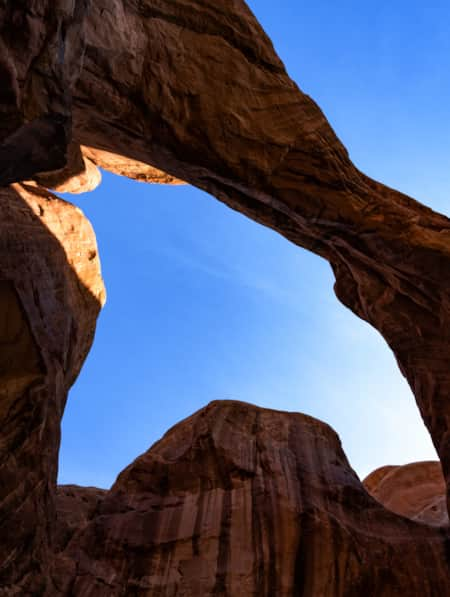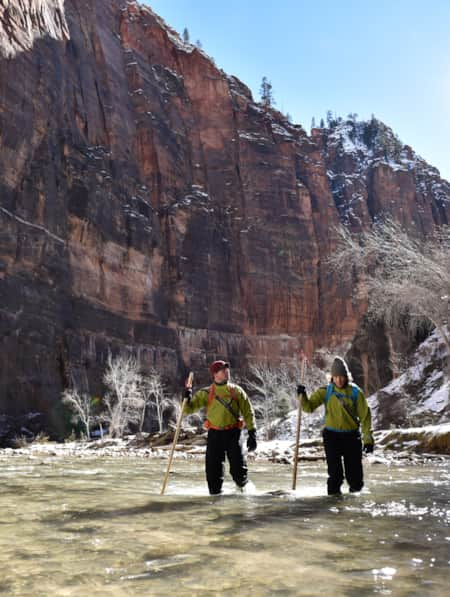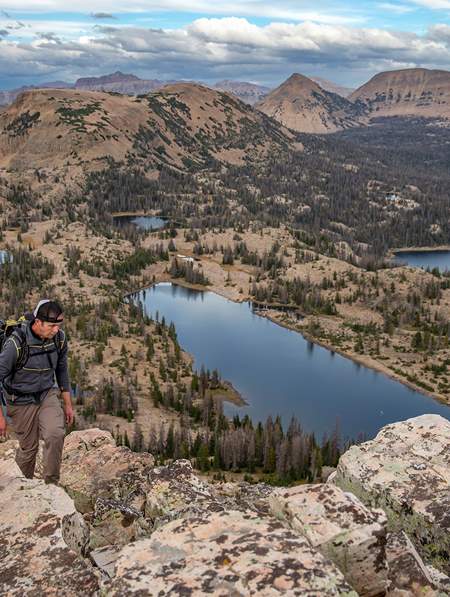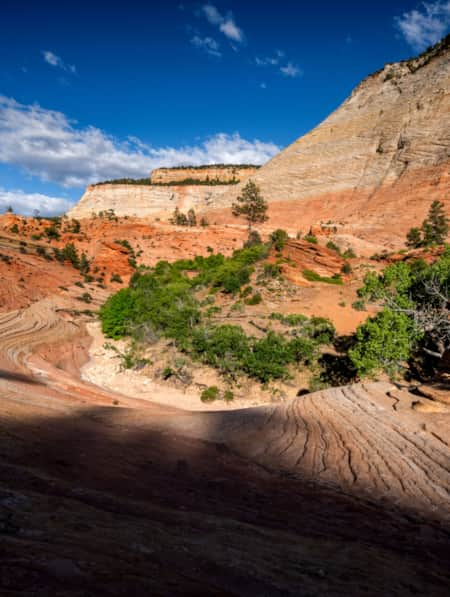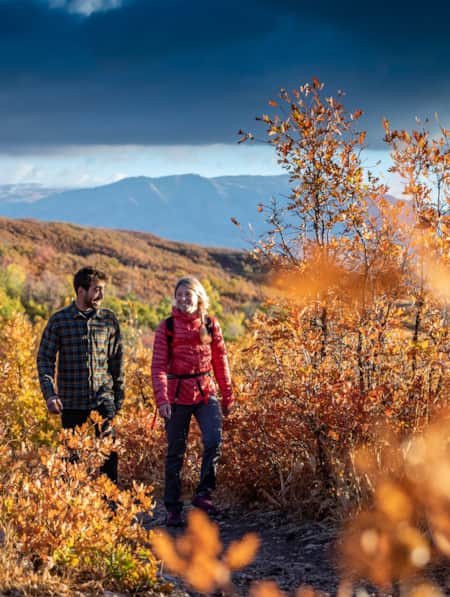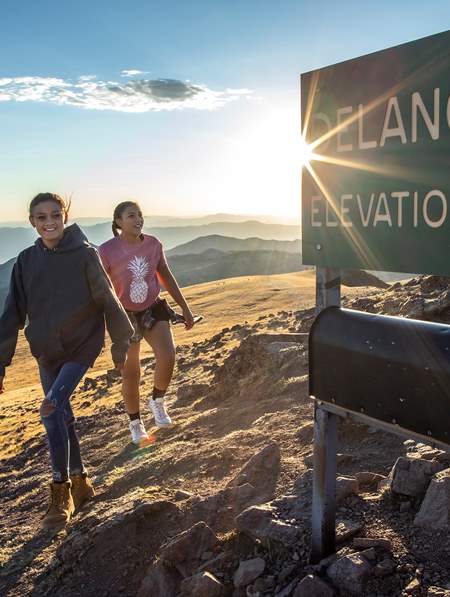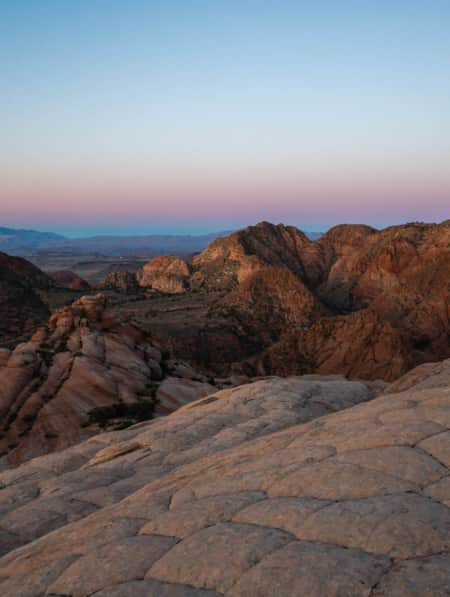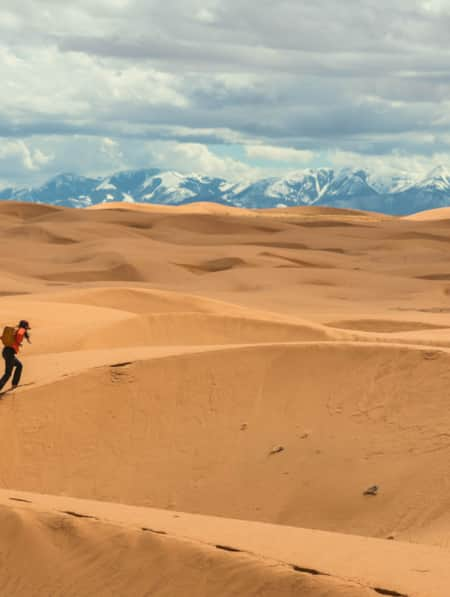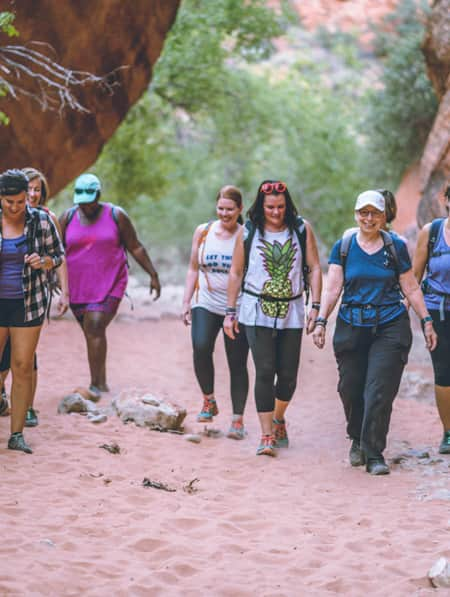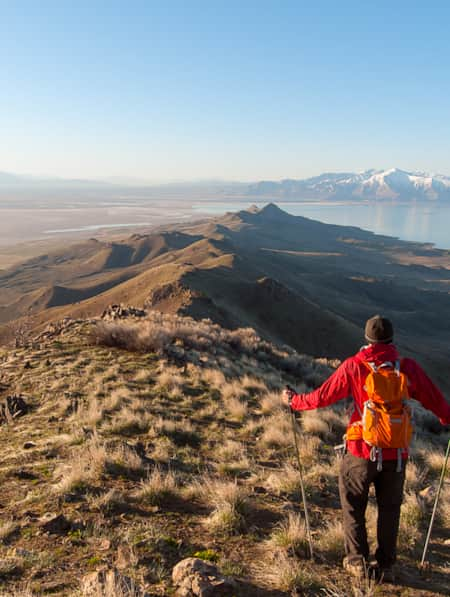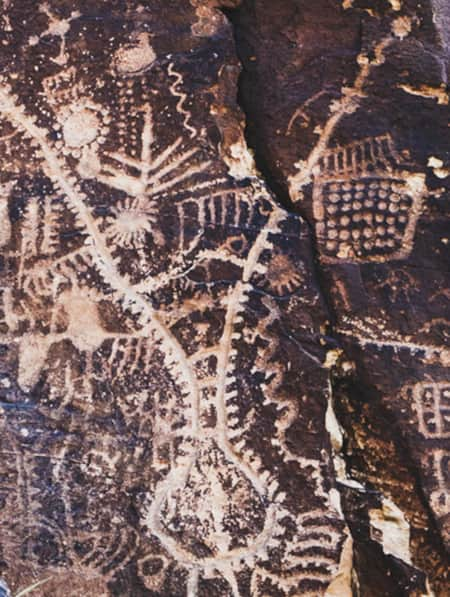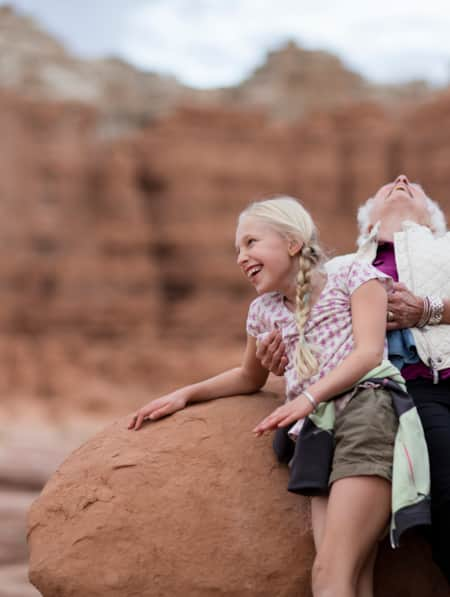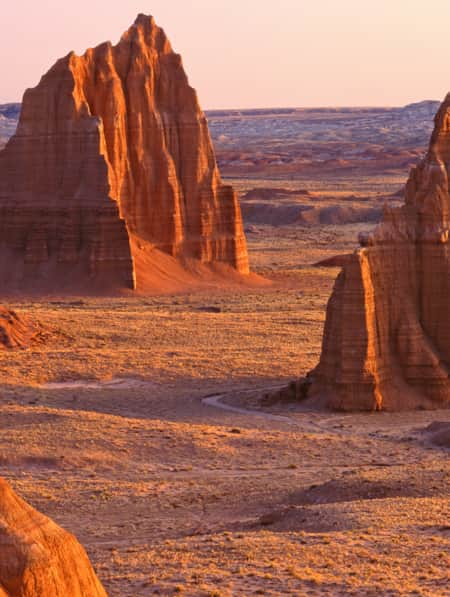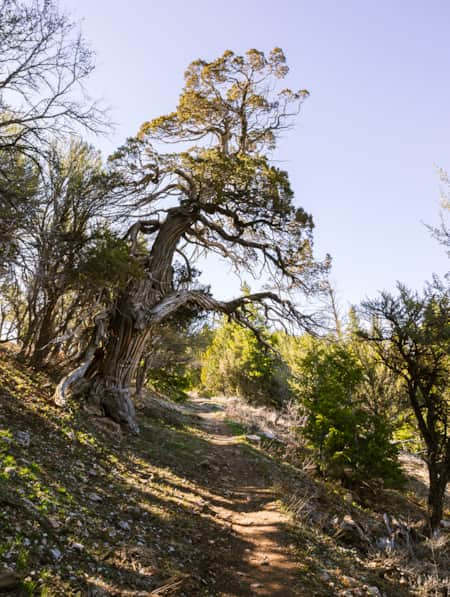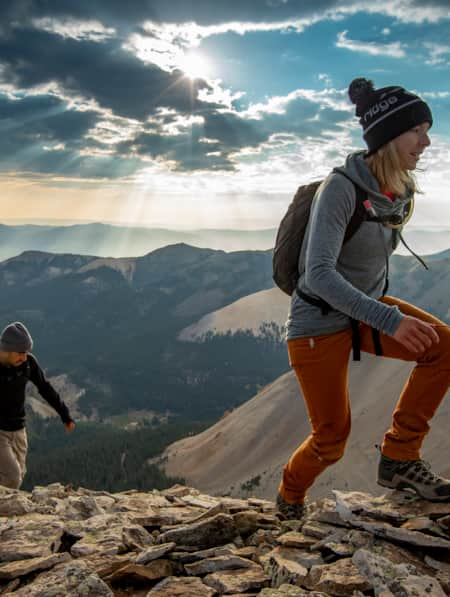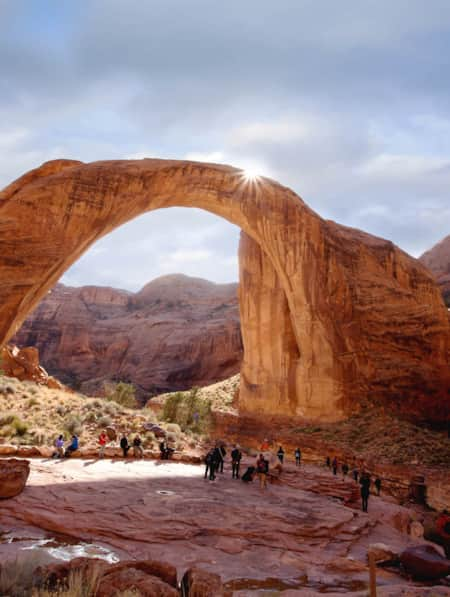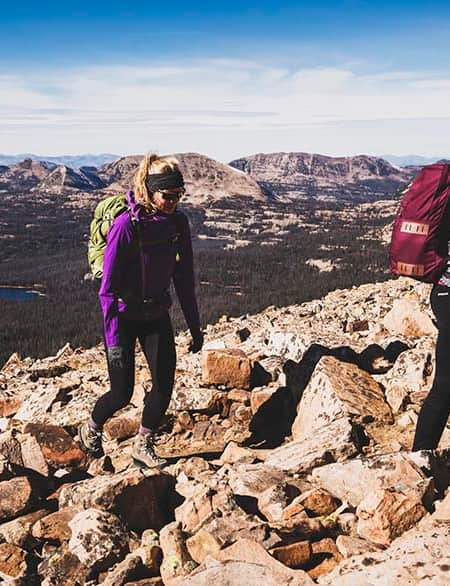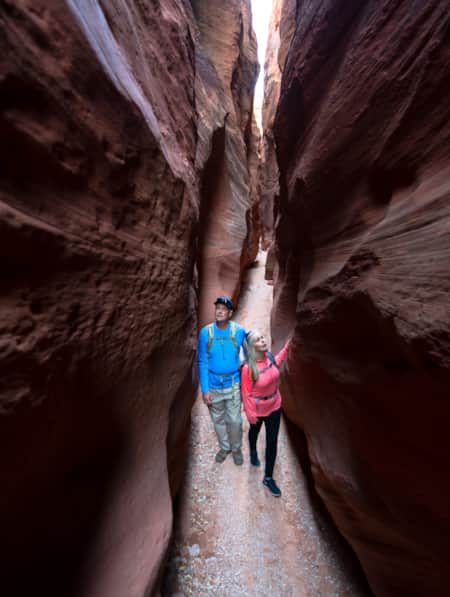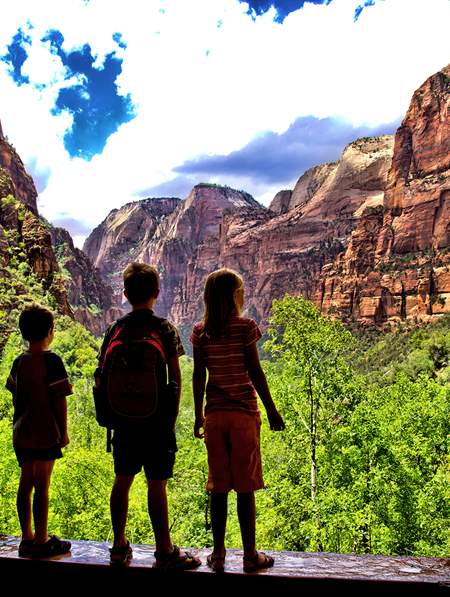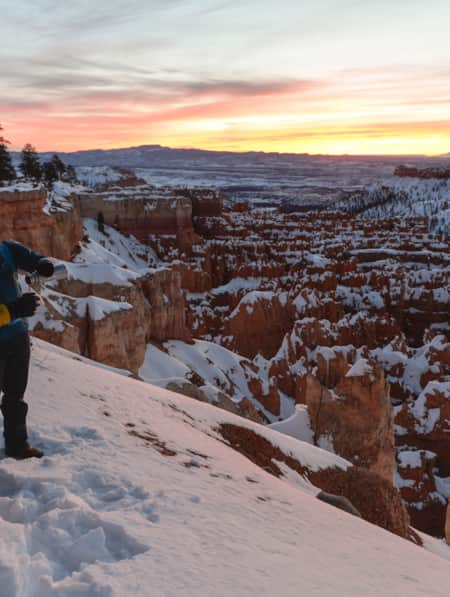- Home
- Things To Do
- Hiking
Hiking
On a hike in Utah, you can stretch out at 13,000 feet above sea level and gaze out over alpine lakes and dense forests of pine and aspen thousands of feet below. Or, pull on shoes suitable for hiking in water and step into a stream for a journey through a mystical desert canyon with periodic swim breaks beneath beautiful waterfalls. Crane your neck as your pace slows, walk beneath natural bridges, and wonder what life must have been like for the Anasazi who lived here a thousand years ago.
Where to Hike
More than 70 percent of Utah is public land. This includes five national parks, nine million acres of national forest, millions of acres belonging to the national monuments and national recreation areas (including the monumental Grand Staircase-Escalante and diverse Flaming Gorge) and 42 percent of the state's land managed by the Bureau of Land Management. All of these locations add up to unbelievable choices for hiking trails that would take more than a lifetime to complete. So, it's time to get hiking.
Northern Utah
In Northern Utah, spend some time checking out trails in the Salt Lake City area. Then gain a little elevation in the High Uintas, Utah's highest mountain range, accessed from Kamas, Utah, only 20 minutes east of Park City, or 45 minutes from Salt Lake City.
Southern Utah
If your Utah trip takes you to Southern Utah, see our guide for hiking in Southern Utah, as well as our guide for hiking in Moab, for family and adventure hikes across that famous Utah red rock in Zion and other destinations.
Hiking in the National Parks
-

Arches National Park Hikes
Arches National Park is one of the most popular hiking destinations in Southern Utah. Start planning your hiking trip with these trails!
-

Bryce Canyon Hikes
Hiking through Bryce Canyon National Park is one of the best ways to see the park’s famous hoodoos, spires and sandstone fins.
-

Canyonlands National Park Hikes
Not sure which trails to hike on your next Canyonlands trip? Here are the 6 best hikes in the park, as well as some very close by!
-

Capitol Reef Hikes
Discover the best family-friendly hiking trails, slot canyons, canyoneering routes and backpacking expeditions in Capitol Reef National Park.
-

Zion National Park Hikes
Visiting Zion National Park? Here are the best hikes in Zion for all hikers, from family-friendly trails to multi-day backpacking trips.
"I was here, I saw this and it mattered to me."
– Alain de Botton, The Art of Travel
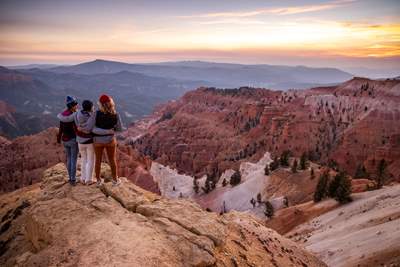
The brilliant geology and vibrant environment of Cedar Breaks National Monument makes for a stunning hiking location.
Photo: Jay Dash
Hiking Tips
Before setting out on any hike, check with local rangers or guidebooks about a hike's difficulty ratings, descriptions and cautionary advice.
Observe the seasons. Trail conditions vary with each season and can determine whether you choose to head for the mountains or opt for a desert hiking trail.
Never hike alone, always tell your friends and family where you are going and when you plan to return, and keep them updated on your location if possible. Learn more about how you can support Utah’s local search and rescue teams with a Utah Search and Rescue Assistance card.
Always carry plenty of water in both the deserts and mountains. Each person should carry one liter of water for every two hours of hiking time. For a full day hike, that adds up to one full gallon per person. It's important to keep hydrated, even if you don't feel thirsty.
Bring plenty of high-energy snacks that will help keep your energy up all the way back to your car.
Practice Leave No Trace principles along the trail and respect nature’s desired and needed permanence. (Read: How to Visit Rock Imagery Sites Like an Archaeologist)
See these resources for traveling thoughtfully and experiencing Utah most fully.
Most importantly, have a safe, fun and rewarding experience hiking in Utah — oh, and let us know your favorite hikes by posting on social media with the hashtag #VisitUtah.
Discover More Utah Hiking
-

3 Hikes That Showcase the Raw, Dramatic Beauty of the High Uintas Wilderness
Written By Matcha
Utah’s High Uinta Wilderness displays some of the most impressive and classic Rocky Mountain beauty that Utah has to offer. Here are three of the best trails to experience this rugged part of Utah for yourself.
-

7 Trails Near Zion National Park to Expand Your Hiking Experience
Written By Monique Beeley
7 minute read
While Zion Canyon is the centerpiece of Utah’s most-visited national park, there are a number of options for well-prepared hikers looking to deepen their familiarity with the landscape of southwestern Utah and to seek solitude among the red rock. Start exploring with these seven trails and destinations.
-

8 Utah Hikes for Leaf Peeping and Natural Splendor
Written By Austen Diamond
6 minute read
When the leaves change, road trips through Utah’s mountains and forests take on a colorful new glow. Unlike their well-trodden counterparts on the East Coast, Utah’s fall foliage and trails are less well known among the broader leaf-peeping community.
-

A Hike to Timpanogos Cave
Written By Cody Kirkland
3 minute read
A mile-and-a-half hike to the entrance to the cave, you run your hand over tiny fossilized shells and coral embedded in the smooth Deseret limestone cliff. It’s hard to imagine that at 6,730 feet above sea level, you’re standing on an ancient shoreline. Inside the caverns, things get really interesting.
-

An Insider's Guide to Hiking in the Tushars
Written By Matcha
4 minute read
One of Utah’s best-kept hiking secrets, the Tushar Mountains deliver sun-dappled trails, wildflower-sprinkled meadows, shaggy mountain goats and forever views from rocky summits. Check out these six choice Tushar trails and make plans to discover Utah’s third-highest mountain range.
-

Best Hikes in St. George During Winter
Written By Matcha
5 minute read
While Utah's Greater Zion offers a few hundred trails, we’ve highlighted seven of the best hikes in the state's southwestern corner, from deep canyons to high peaks.
-

Elevate Your Hiking with Mindfulness
Written By Annie Hartvigsen
Incorporating simple mindfulness techniques into your next hike can take the edge off anxiety and enhance your overall well being.
-

Five Best Hikes In Bear Lake Valley
Written By Matcha
3 minute read
Follow your Bear Lake hike with a refreshing dip in the lake. Which of these five excellent hiking trails in Bear Lake Valley is your favorite?
-

From Sparkles to Sparks: Just Click Your Heels (or Hiking Boots) and Go!
Written By Paula Colman
Women embrace adventure differently throughout their lives.
-

Hike + Dine: Davis County
Written By Arianna Rees
4 minute read
Here are a few of Utah's Davis County’s best hiking trails and eateries to check out during your next visit.
-

Hike + Dine: Ogden
Written By Mitchell Reber
4 minute read
Head north of Salt Lake City for trails and ales. Enjoy these 6 Ogden hikes, followed by their complementary restaurants tied to a booming dining scene.
-

Hike + Dine: Provo
Written By Arianna Rees
4 minute read
Here are a few of Provo, Utah's best hiking trails and eateries to check out during your next visit.
-

Hike + Dine: Salt Lake City
Written By Mitchell Reber
4 minute read
Here are a few of Utah's Salt Lake City best hiking trails and eateries to check out during your next visit.
-

Hike Among Traces of the Ancients at the Mysterious Parowan Gap
See an impressive number of panels covered in petroglyphs. Some people believe that the Gap was considered a special place at certain times.
-

Hiking Southern Utah with Younger Children: Tips for Family Friendly Adventure
Find safety tips, side activities and kid-friendly hikes in Utah with our special guide to hiking Southern Utah with children. Read now!
-

Hiking the Desert in Capitol Reef National Park
Written By Visit Utah
-

Hiking the Jardine Juniper Trail to the Oldest Rocky Mountain Juniper Tree in the World
Written By Matcha
4 minute read
Enjoy this scenic hike up Logan Canyon through aspens with mountain vistas along the way to an ancient juniper tree. All abilities are welcome.
-

How to Day Hike Three Different Sections of the Scenic 23-Mile Skyline Trail
Written By Matcha
5 minute read
As a long day hike or multi-day excursion, this remote trail offers superb hiking, gorgeous scenery and, if you’re lucky, the chance to observe a herd of mountain goats.
-

Insider's Guide to Hiking Rainbow Bridge National Monument
Written By Matcha
From choosing the best season and trail, to understanding logistics and history, here's what you need to know to hike Utah's Rainbow Bridge National Monument located off the south coast of Lake Powell.
-

Introduction to Hiking Utah's High Uintas
Highlights of local hiking trails in the High Uintas include stellar views of sparkling lakes in a lush alpine environment. Get a multi-day pass for your hiking adventure!
-

Slot Canyons: A Guided Hike Through Nature's Masterworks
Written By Visit Utah
4 minute read
It's said that southwestern Utah offers the highest concentration of slot canyons in the world. Well-prepared visitors can hike right into some of them, but the best experience is with a guide.
-

Top 10 Family-Friendly Hikes in Utah National Parks
With so many destinations, and so many trails, it can be difficult to decide where to begin in Utah's Mighty 5® national parks. Here are 10 family-friendly hikes, two per national park, you cannot miss.
-

Winter in the Bryce Canyon Area: Hiking, Cross-Country Skiing and Snowmobiling
Written By Jeremy Pugh
4 minute read
Learn more about why Bryce Canyon and the surrounding areas are the perfect place for winter hiking, cross-country skiing and snowmobiling.
